This is a complete guide to visiting Trinity Site.
In today’s guide you’ll learn:
- How to get there
- Before you go
- Every location to visit
- FAQ
- A Brief History of the Trinity Site
In short: if you are planning a visit to Trinity Site, you’ll love this new guide.
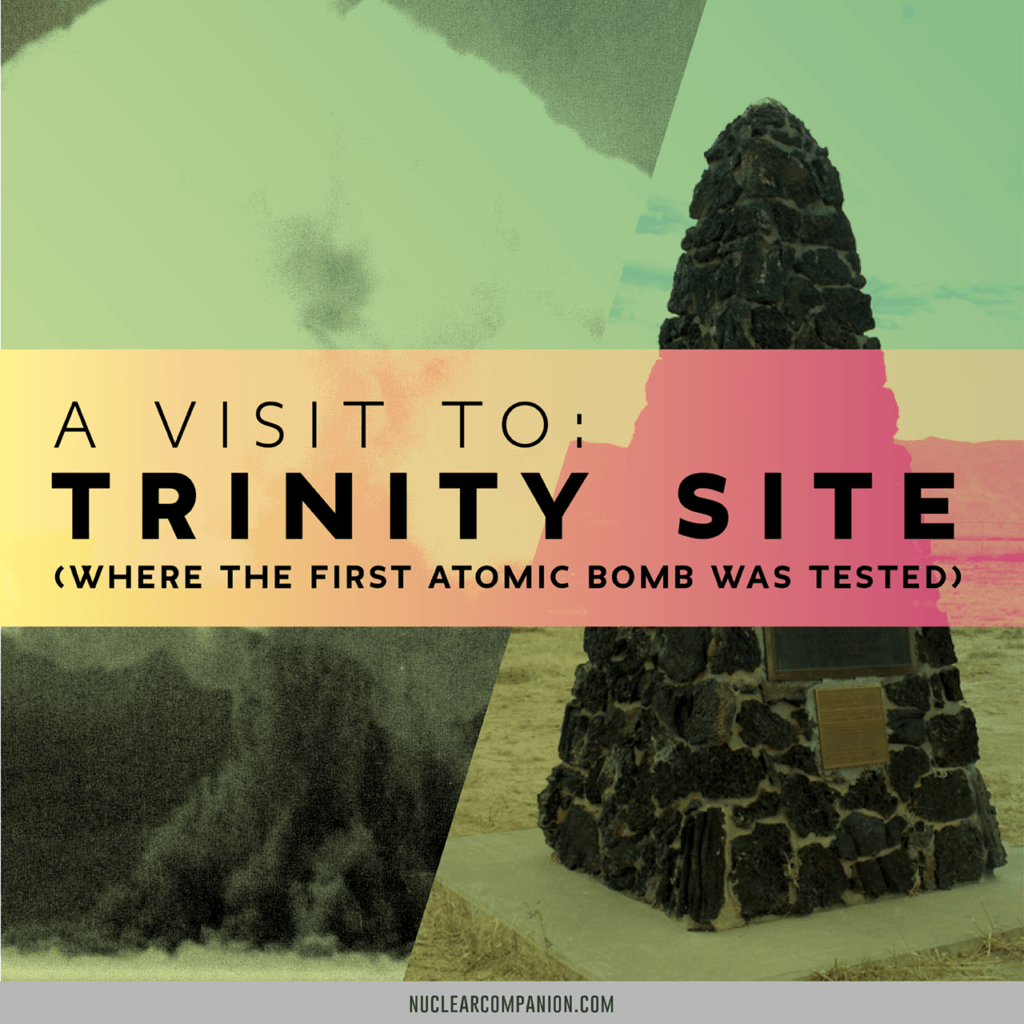
Trinity
Trinity was the code name for the first test done on a nuclear weapon. Today, it also refers to the geographical area where the test occurred in the Jornada del Muerto (“Journey of the Dead Man”) desert in New Mexico. If you are interested in visiting the site, first understanding the history behind it will help to enrich your experience.
Trinity Site Open House
Please understand that the only time you can see the Trinity test site is on open house days, which occur twice per year. Military leaders oversee the open houses. Stationed nearby the base, they offer an immersive experience into understanding the importance of the Trinity site.
White Sands Missile Range (WSMR) is an active military site. Much of the site is closed to the public because it is within the missile impact zone.
Open houses only occur twice per year, on the first Saturday of April and October. As you can imagine, thousands of people come to the site on these dates to take part in the open house, so you need to plan your trip well in advance. The open house is from 8 am until 2 pm, so it is a full day with a lot of learning experiences built into it.
Suggestion: Get there early
If you don’t like fighting a crowd and long lines for everything, get to the Stallion Gate at 7:00 AM or 7:30 AM before the site opens at 8:00 AM.
How to Get There
The Trinity test site is located at the White Sands Missile Range, off of Highway 380 in White Sands, New Mexico. Keep in mind that if you want to visit on an open house day, you will need to plan to go either on the first Saturday of April or the first Saturday of October. Those are the only two days each year the tour is available.
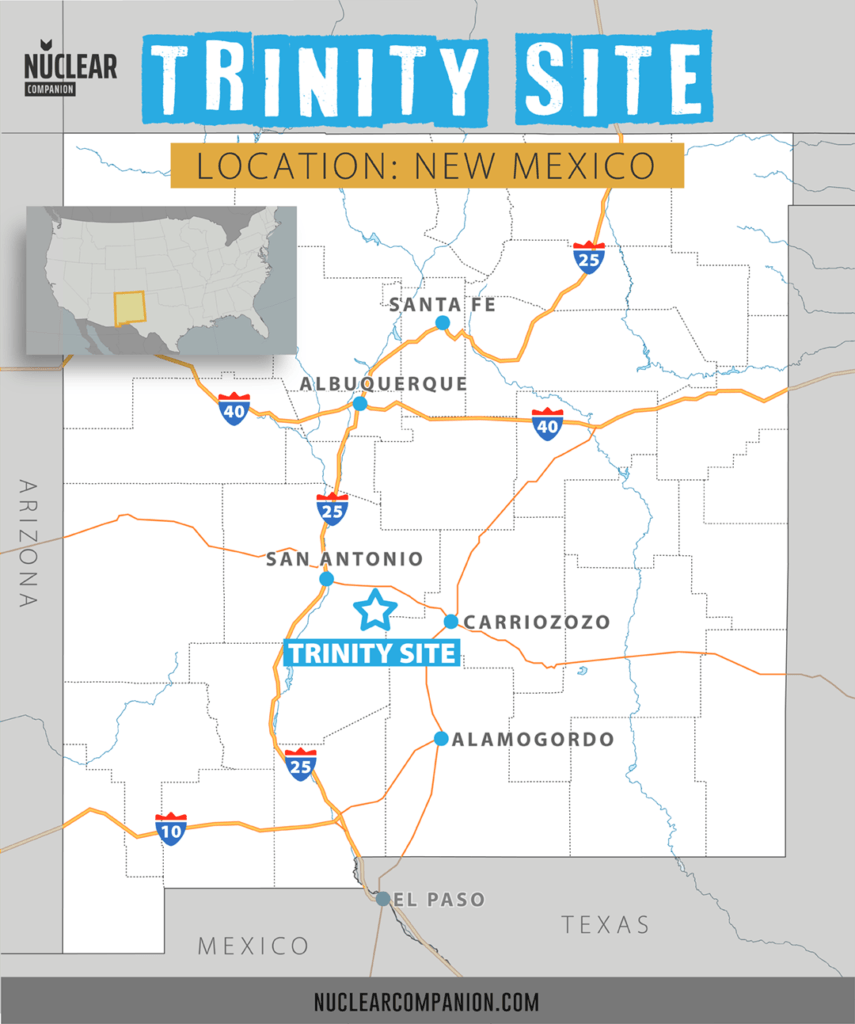
White Sands is not a city but rather a census-designated place (CDP), meaning that you will find residents but very few amenities, such as restaurants and hotels. If you need a place to stay overnight, you will probably want to make reservations in Las Cruces, which is about 27 miles west, or another nearby city.
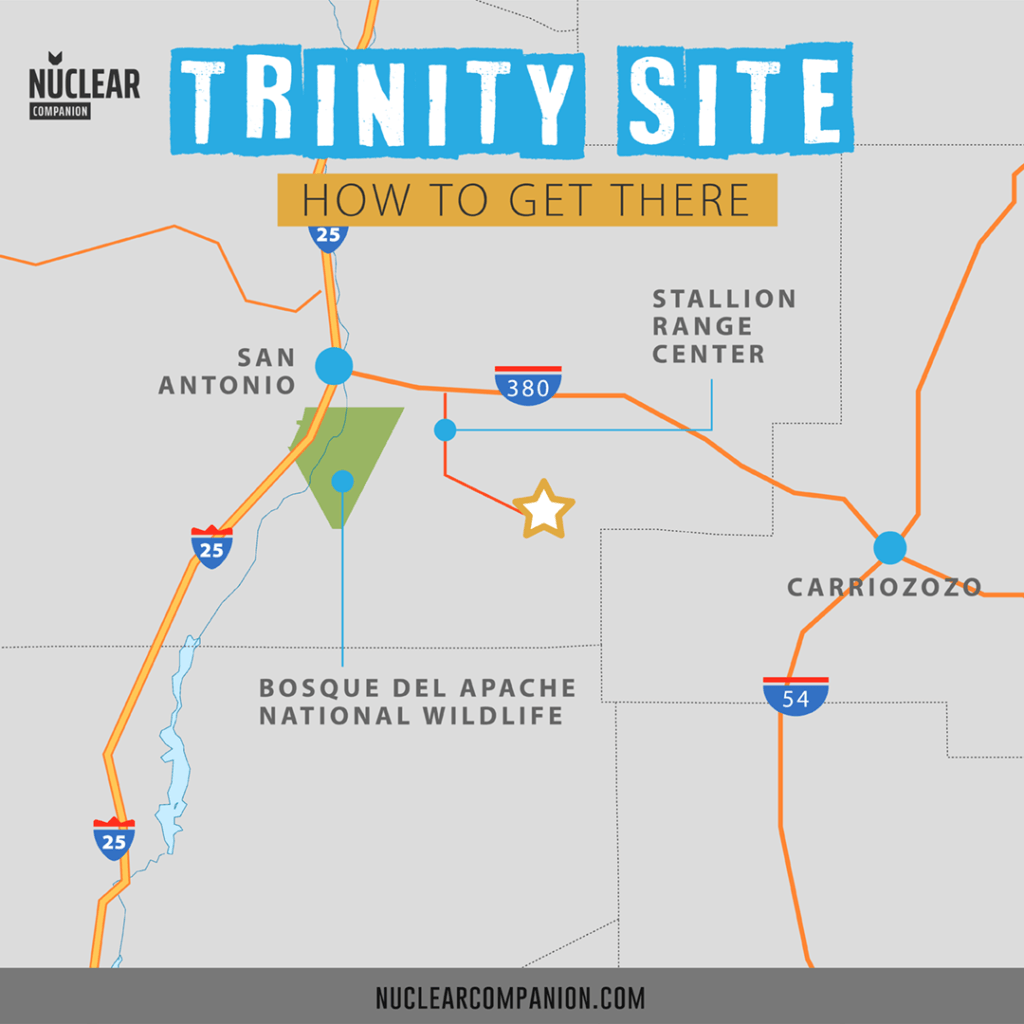
To get to the Stallion Gate Entrance from San Antonio, New Mexico, take Exit I-25 on mile marker 139 and travel 12 miles east. To get there from Carrizozo, take exit Highway 54 onto Highway 380 and head west for 53 miles. From the Stallion Gate Entrance, you will go another five miles off the highway. It is easy to follow because the site is marked clearly from Highway 380.
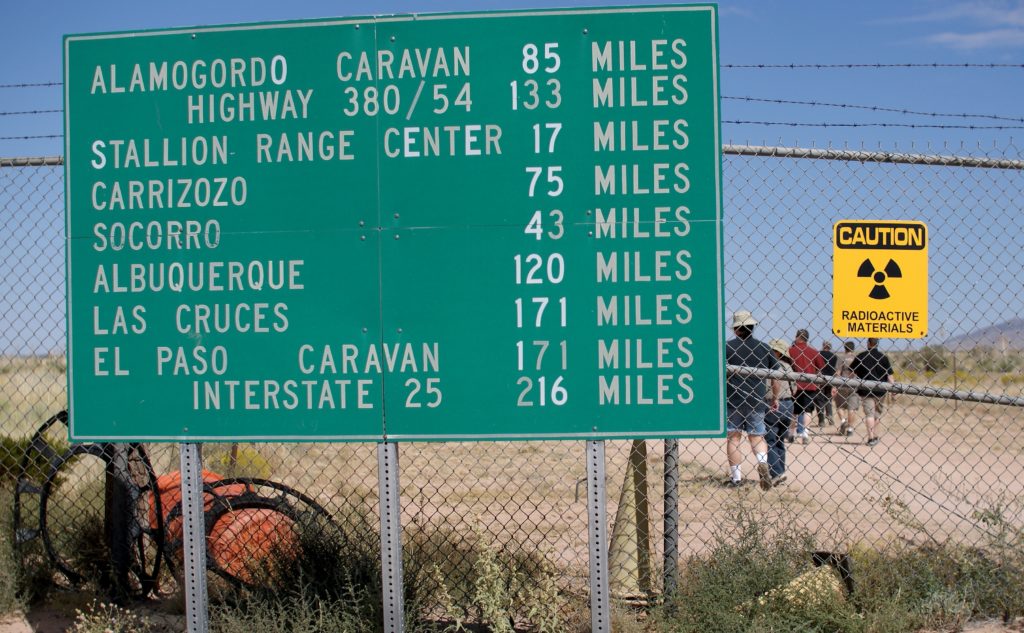
Today, the 51,500-acre site that composed the test site is a National Historic Landmark. Included in the landmark are the McDonald ranch house, Ground Zero, and the base camp. If you go on an open house day, you can see Ground Zero for yourself. This area includes the bomb casings known as “Jumbo” and “Fat Man,” historical bunkers, and parts of the crater left by the explosion. The element created as a result of the blast, Trinitite, is also on display.
Before You Go
Please understand that even though the test site is a tourist attraction and National Historic Landmark, it is part of a military base. Vetting takes place before you can enter. Make sure that you have government-issued photo identification (a valid visa if you do not have a US passport). You also need proof of car insurance and car registration. If you have a rental car, make sure that you also bring the agreement from the rental car company.
Be aware that at the site, there will be no food or water; you need to come prepared. There are port-a-potties but no standard bathrooms. However, you may want to bring wet wipes to wash your hands.
If you visit on a day that is not an open house, you may be required to have a military escort to enter the site. The gate usually closes at 3:30 pm, so make sure that you plan to arrive somewhat early in the day. On open house days, the gate is open from 8 am until 2 pm, and you can pass through without an escort.
Before going, make sure that you check with the White Sands Missile Range personnel to ensure that you will be able to get to the site. Once there, you will not be able to leave the road due to unexploded ordnance. You may bring a dog as long as it is on a leash and well-behaved; make sure that you bring a bag to clean up any dog waste.
Is radiation at Trinity dangerous?
Some people are concerned about radiation exposure at the site. Radiation at Trinity is ten times higher than the surrounding areas; you can expect that within one hour of being there, half of the radiation that you would typically receive within an entire day will impact you. If you are concerned about radiation exposure, make sure that you wear long sleeves, pants, and a hat (this attire will also protect you from the desert sun and wind).
Locations to Visit
When you visit Trinity, there are many different locations at the site that are worth your time to visit. Keep in mind that the site is an active military base, not a museum. There is very little to indicate that anything of importance happened there on July 16, 1945. What is there – the McDonald House, Jumbo, Ground Zero, and more – is well worth your time.
Make sure that you wear good walking shoes. Again, this place is not a museum, and you will be doing a fair amount of walking across hot desert sands.
Trinity Test Site (Ground Zero)
Ground zero is the main attraction and a mandatory visit. As you could expect, it is a massive circle of 2900 feet in diameter. Its boundaries are a 2.4-meters chain-link fence called the outer fence.
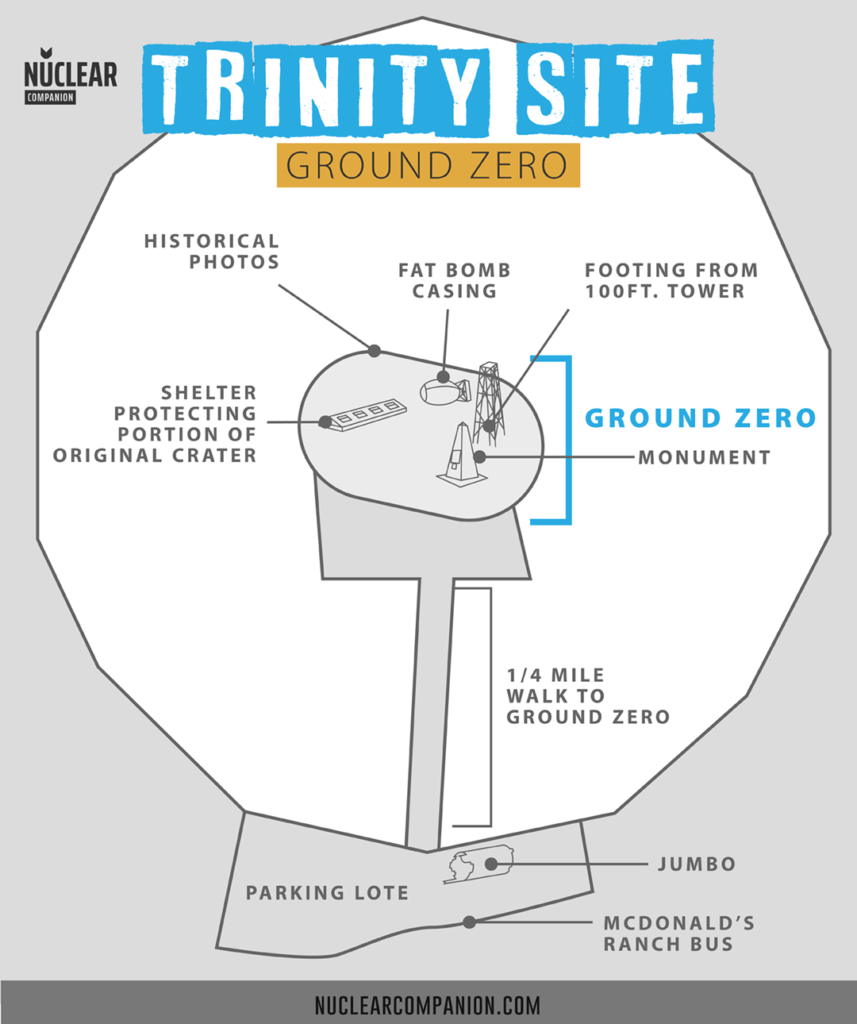
In the center of this GZ, there is a depression. This was the explosion crater, and It also has its chain-link fence. There is a barbed-wire fence connecting both the outer fence and inner fence.
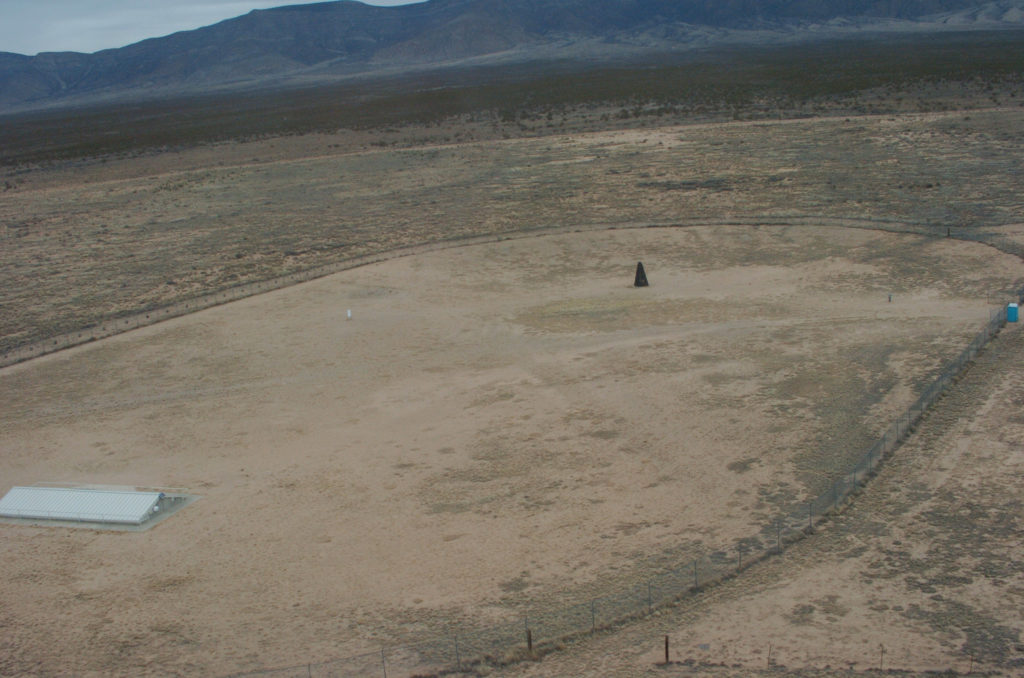
What can you do at Ground Zero?
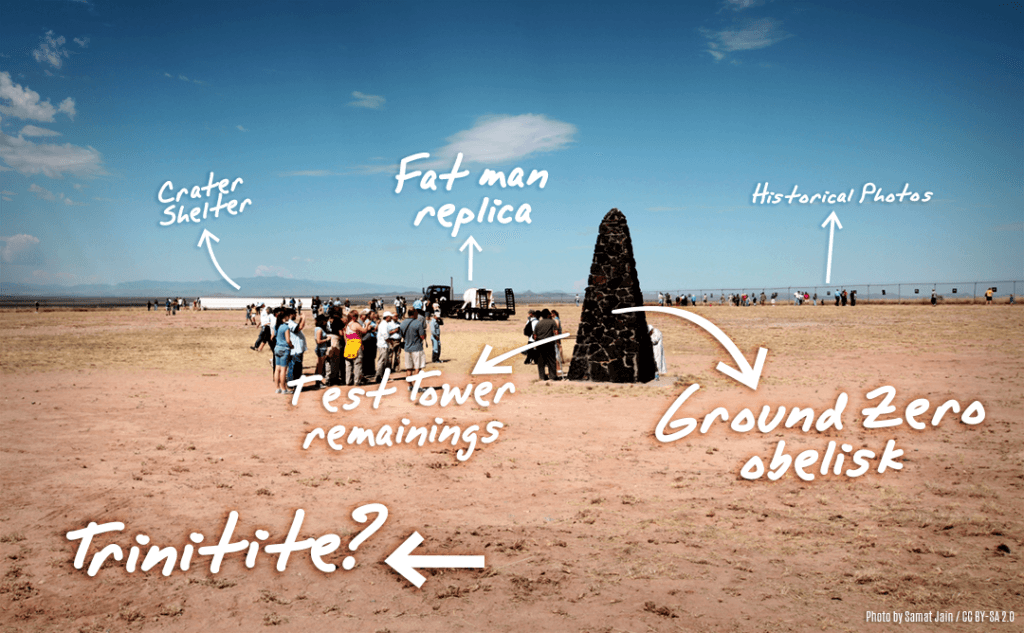
- Visit the ground zero commemorative obelisk
- Look for Trinitite
- Take some pictures of the Fat Man Bomb Casing in exposition
- Stand beside the remains of 100-Foot Tower that hold the bomb
- Take a look at the Shelter protecting a portion of the original crater
- Take a photo inside “Jumbo”
- Navigate the north fence along a series of historical pictures
Let’s get started!
1. Ground Zero Monument
Location: Trinity Site’s inner fence (Google Maps)
The exact point of the blast occurred at ground zero. A 100-foot steel tower was constructed to release the bomb. The point at the bottom base of the tower is ground zero. Today, a stone obelisk marks the spot. It has a plaque that reads, “Trinity Site, Where the World’s First Nuclear Device Was Exploded on July 16, 1945.” It serves as a permanent reminder of the destructive force unleashed there.
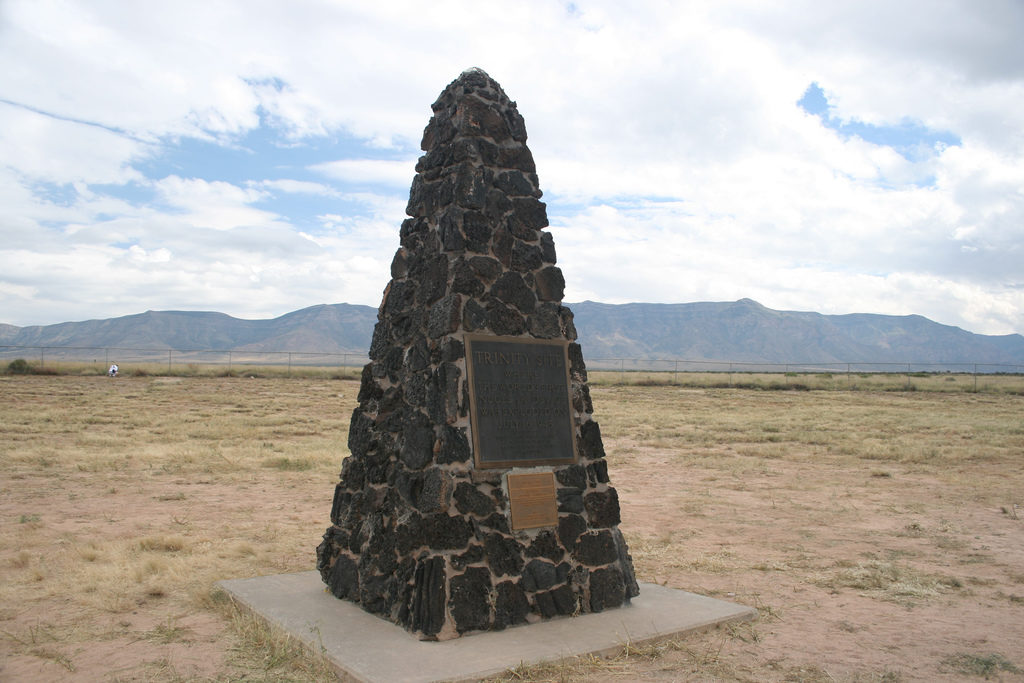
2. Trinitite
The explosion blasted out a crater almost 1,200 feet across and up to 10 feet. It was so powerful that sand at ground zero was fused into a green glassy substance called “trinitite.”
In 1952, most of the Trinitite was removed and buried, while the crater was filled. Only small pieces of Trinitite remained at the site.
During the Open House, you will find a tent where a White Sands Missile Range installation safety officer talks to visitors about radiation and trinitite. Also, there you will be able to see Trinitite samples in a box and radiation detectors that visitors can use.
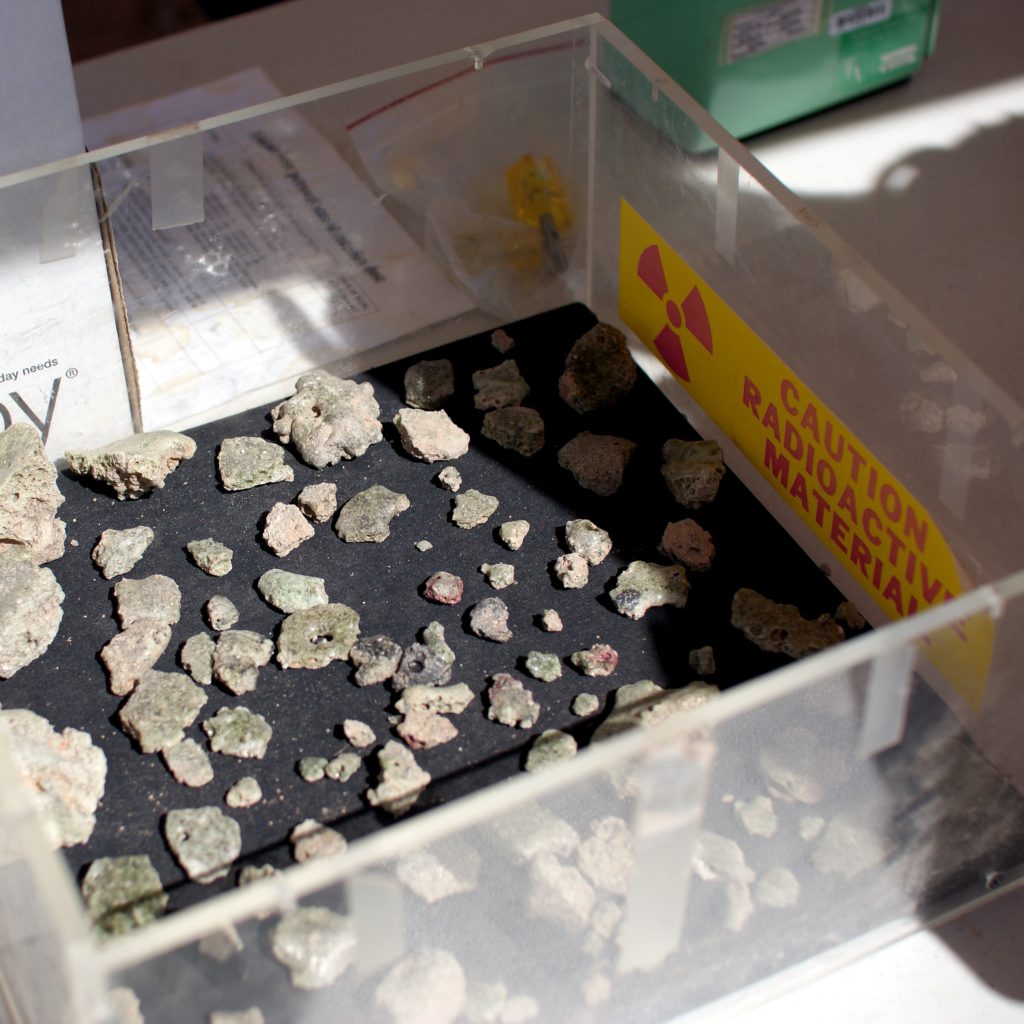
If you are lucky, perhaps you will find some trinitite on the site ground.
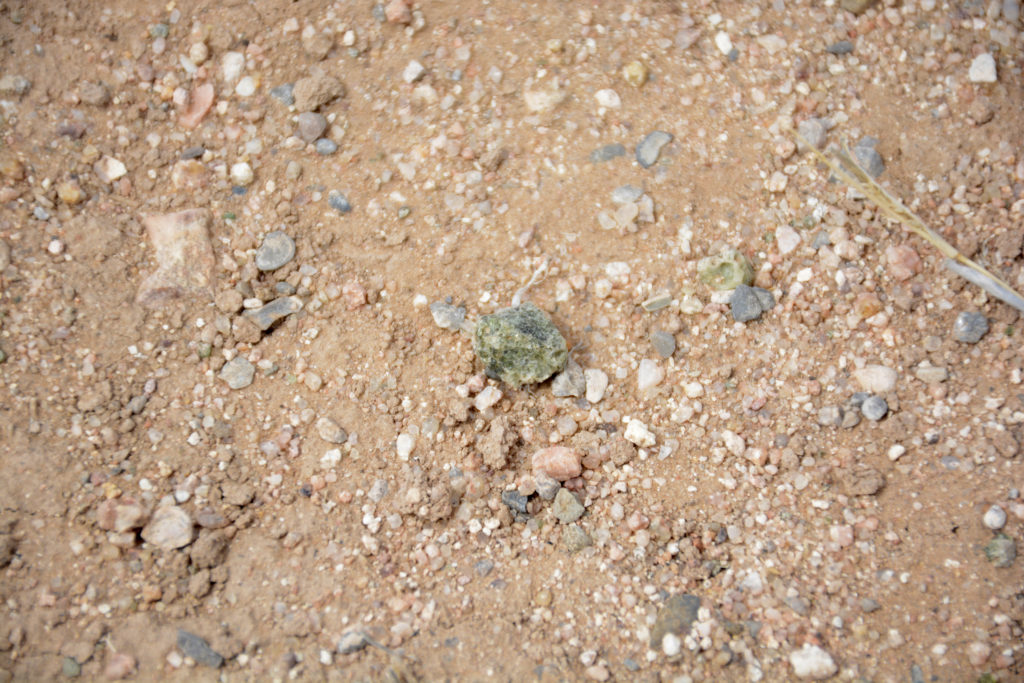
But be careful, the green glassy trinitite is still radioactive and must not be picked up. Also, its removal is illegal:
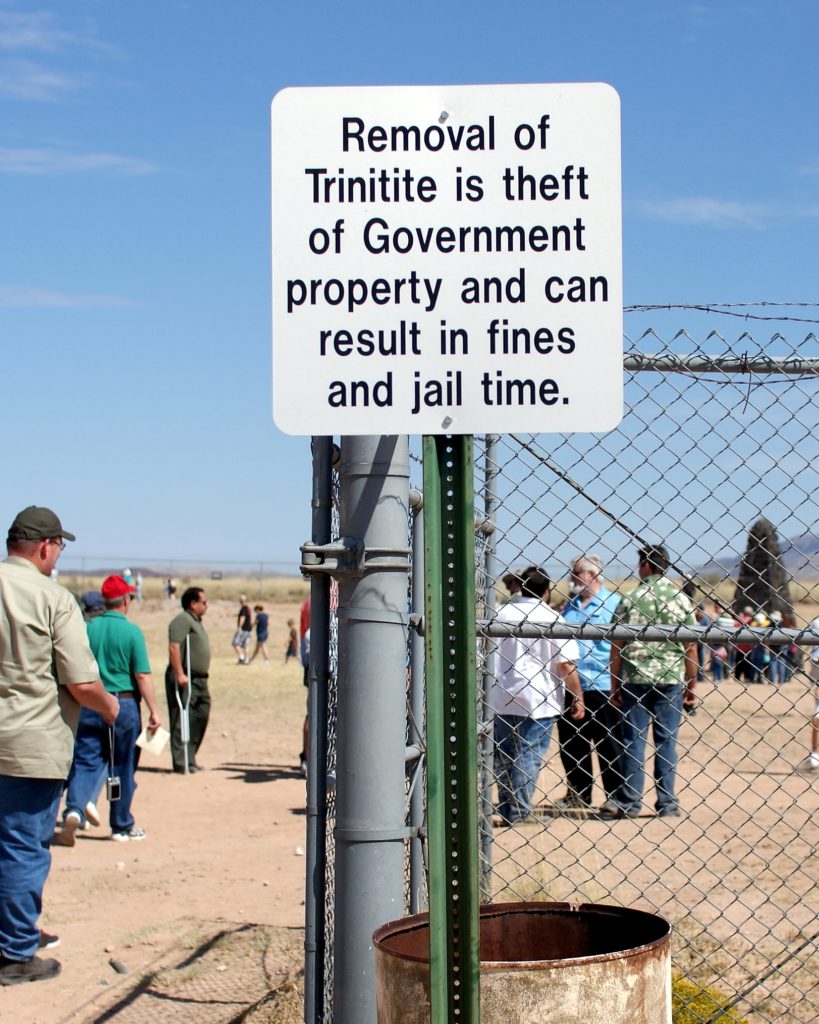
3. Fat Man Bomb Casing
Fat Man was the code name for the atomic bomb dropped on Nagasaki on August 9, 1945. When you visit the Trinity site, you can view the “Fat Man Bomb Casing.” This artifact is a reconstruction of the casing that held the bomb that fell on Nagasaki. During this part of the tour, you will understand how it got its name!
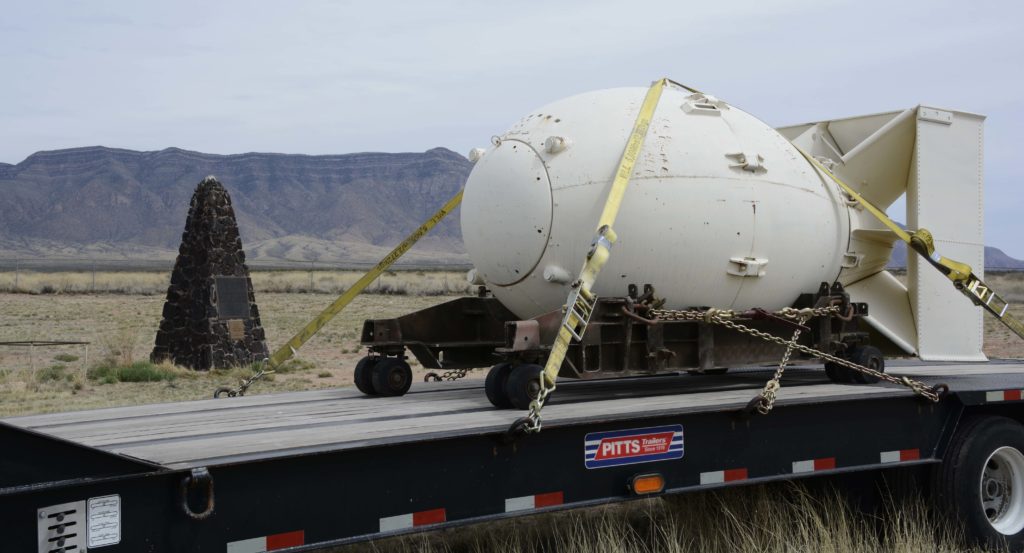
4. Remains of 100-Foot Tower
Location: Trinity Site’s inner fence
The steel tower for the test bomb became destroyed during the explosion. However, you can see the base of it at ground zero.
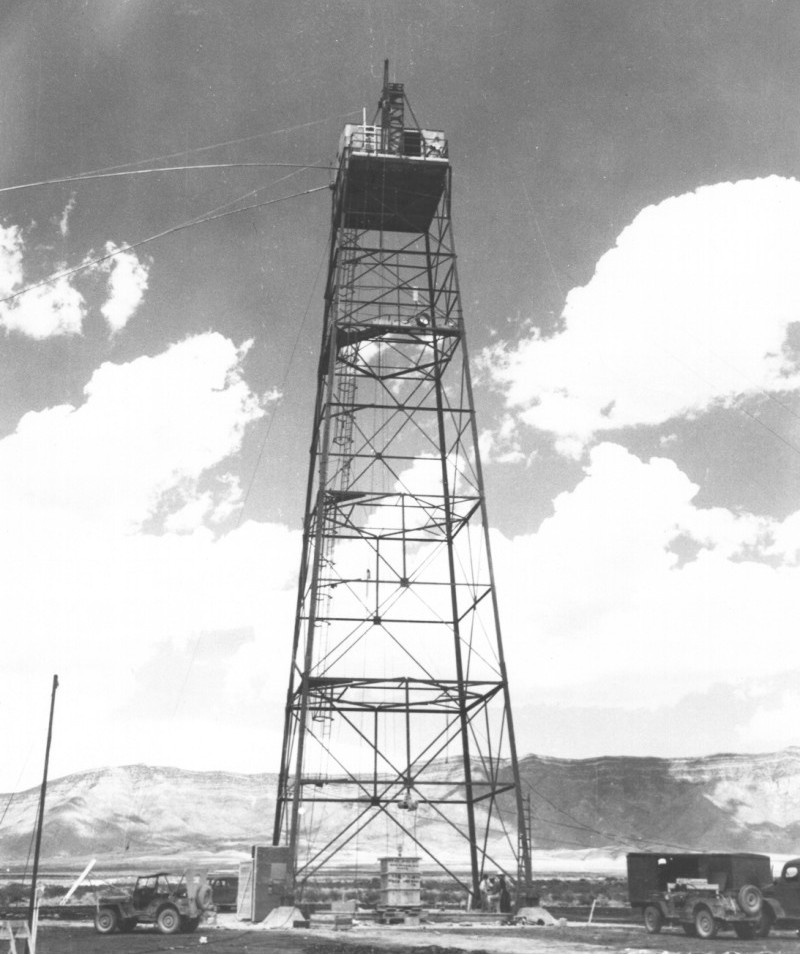
You will probably be quite surprised at how little there is to tell the story of what happened; however, keep in mind the blast ruined many of the structures.
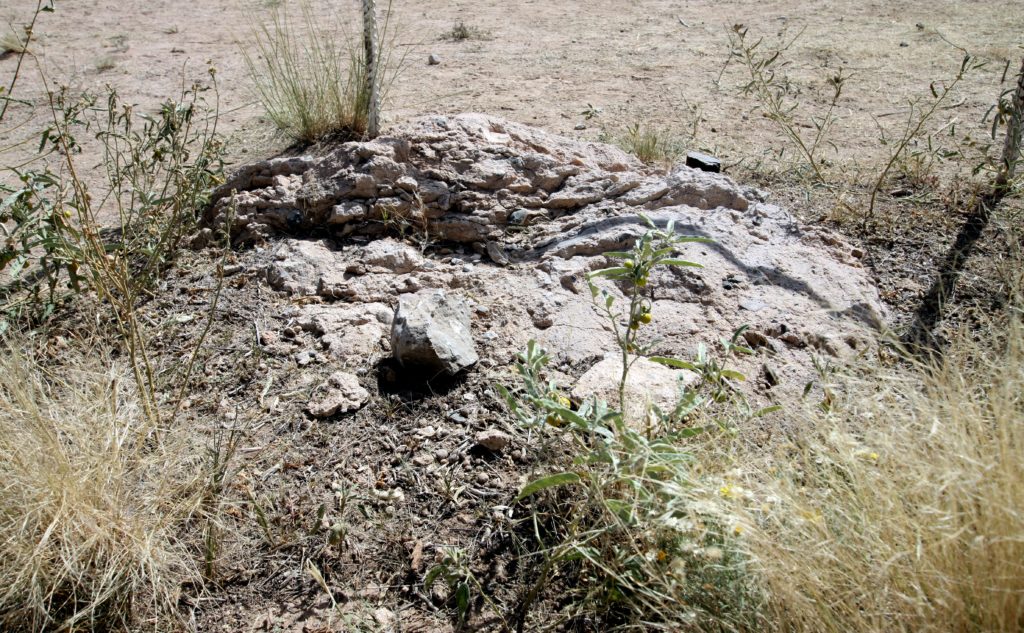
5. Shelter Protecting a Portion of the Original Crater
Location: Trinity Site’s inner fence (Google Maps)
The 1945 detonation created a huge crater and a new substance – Trinitite – from the radioactive glass that formed. Today, the Trinitite has been cleared out, along with the radioactive sand, and the crater mostly filled in. Remember that this site is a military base and missile range, not a museum.
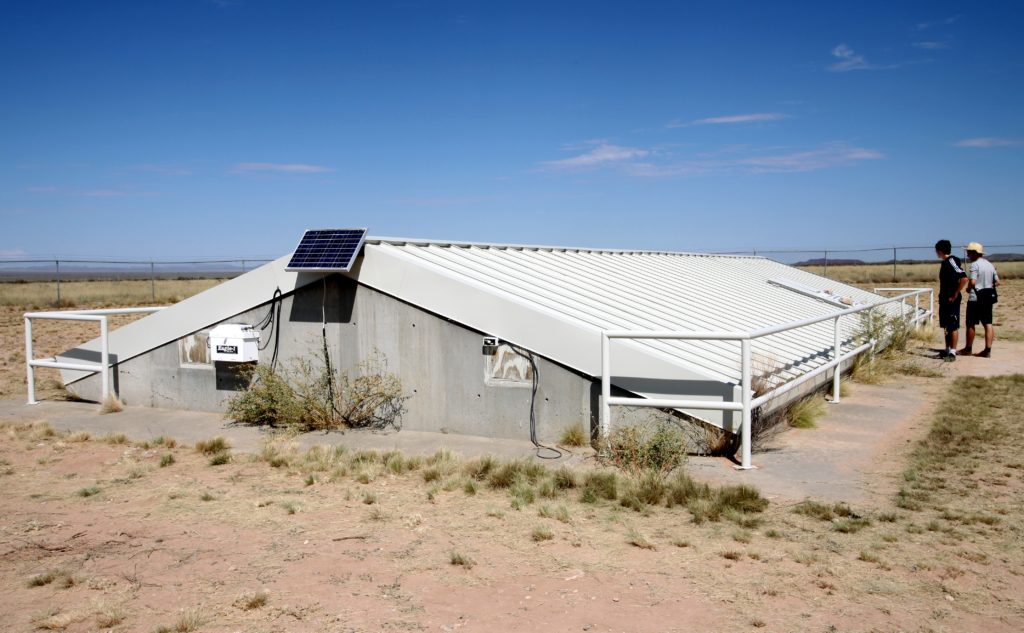
This shed protects an undisturbed portion of the original crater. But, if you would like to take pictures here, you will be disappointed. The shelter’s hatches used to be opened so visitors could see undisturbed Trinitite but sand from windstorms covered it.
6. Remnants of Jumbo
Location: Trinity Site’s parking lot (Google Maps)
Just in case the test proved to be a failure, they constructed a steel canister nicknamed “Jumbo.” It was created to hold the 13-pound plutonium device to protect against its radioactivity. Jumbo earned its name; it was 10 feet in diameter, 25 feet long, and weighed in at 214 tons! A 64-wheel trailer had to be used to haul it to the test site.
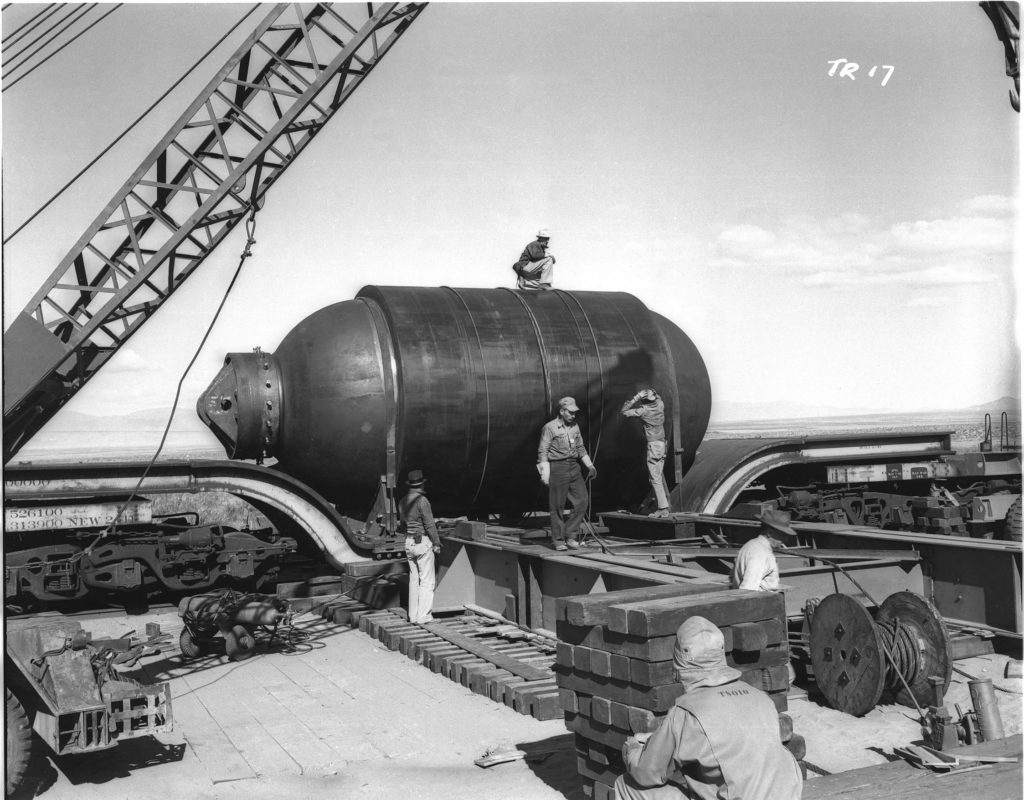
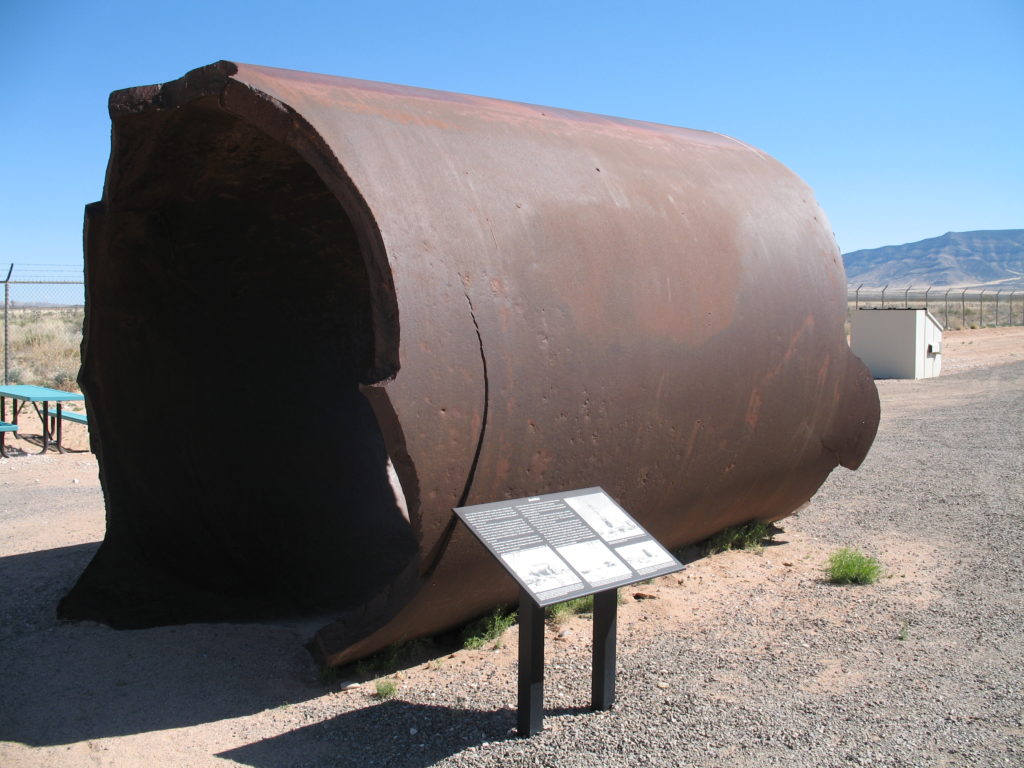
Fortunately, someone thought better of using Jumbo. The test was successful! Besides, had the plutonium been inside a steel case, molten radioactive material would have rained down all across the area. Today, you can see the remnants of Jumbo when you visit the Trinity test site.
Ironicaly, Jumbo is the most memorable permanent object at Trinity Site.
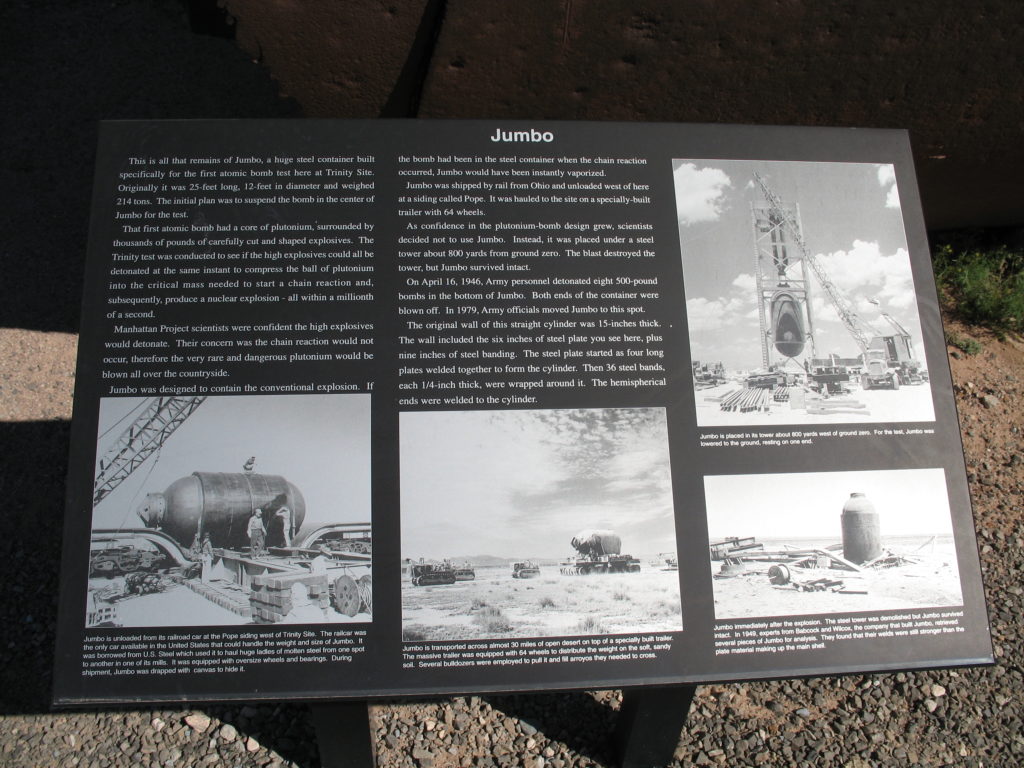
7. Historical photos display
In the north side of the inner fence, you will find a series of professionals photographs hanging from the fence. These are black and white pictures the site days before the explosion, the day itself, the explosion in slow motion and afterward.
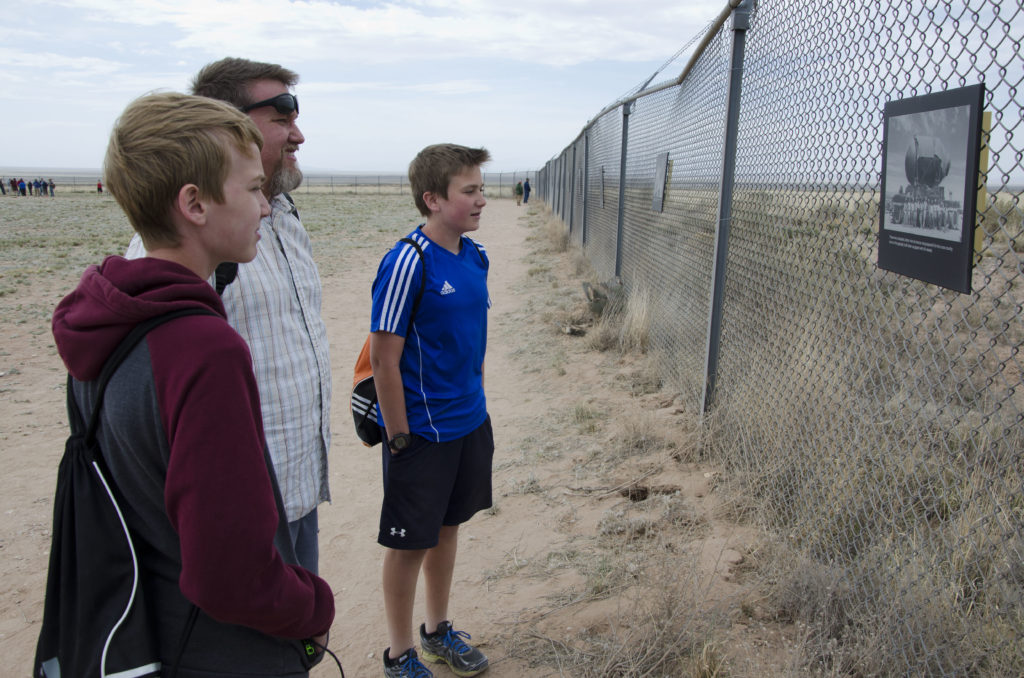
Other locations to visit
Besides Ground Zero, there are other exciting locations to visit.
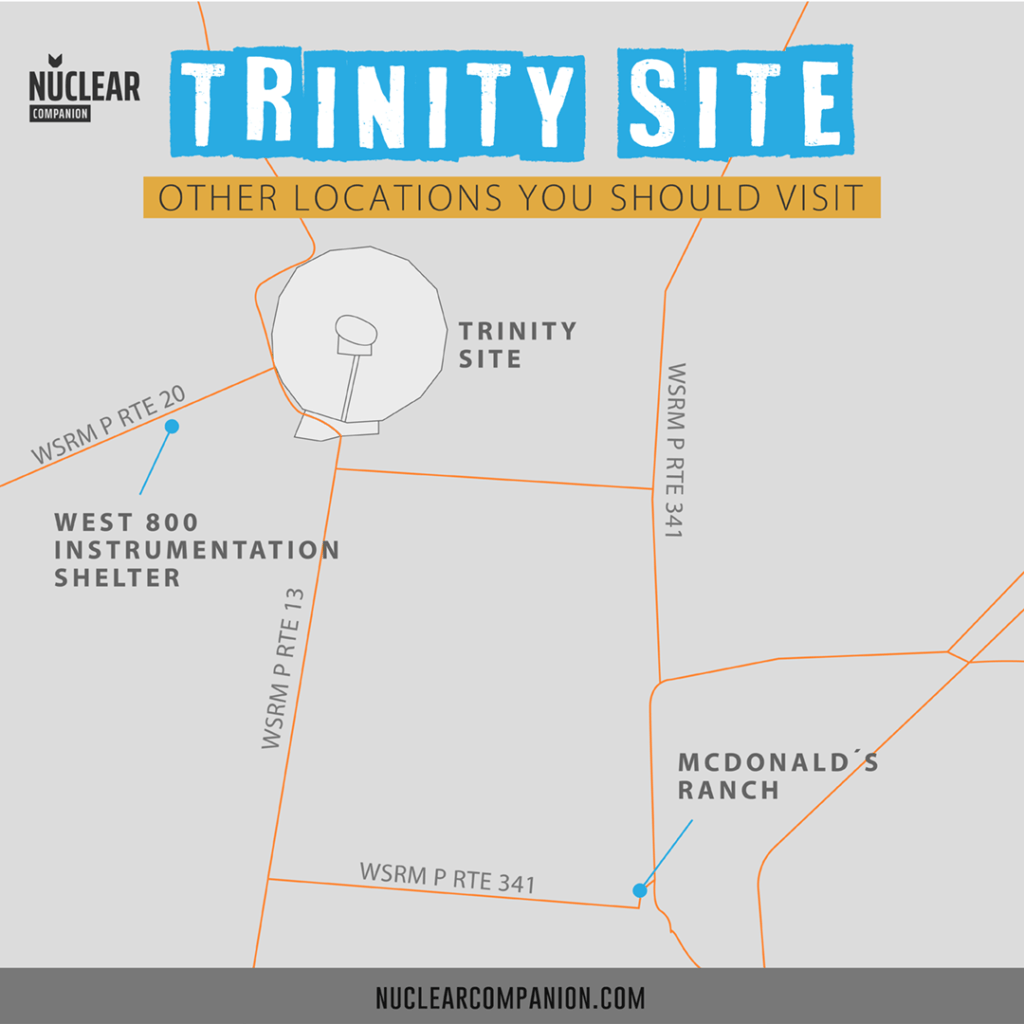
Specifically:
Let’s dive right in.
1. West 800 Instrumentation Shelter
Location: 800 yards from ground zero by WSMR P Route 20 (Google Maps)
The West 800 shelter was an instrumentation bunker. During the test, it contained equipment for measuring implosion characteristics. Up to the date, it is the only bunker that visitors can see.
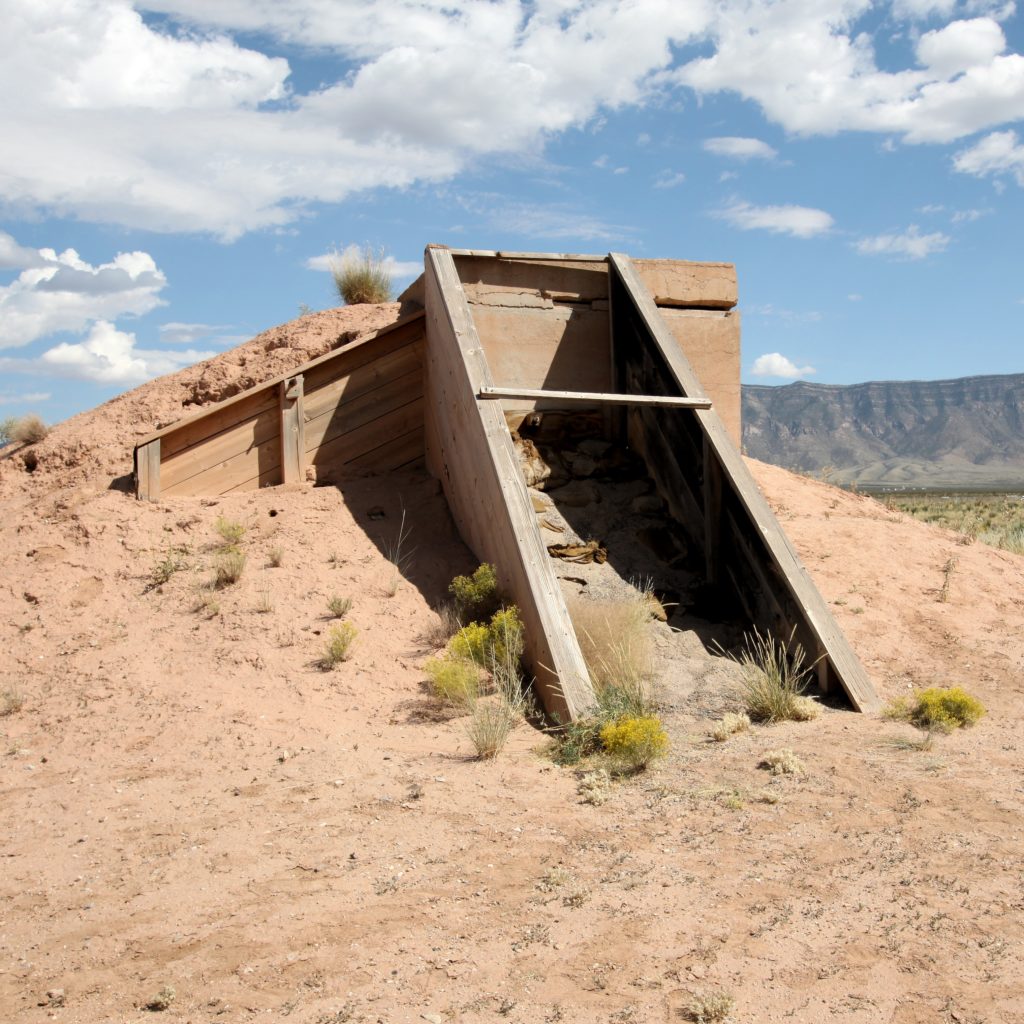
Originally, there were seven bunkers. One control bunker, two manned observation bunkers and four instrumentation bunkers.
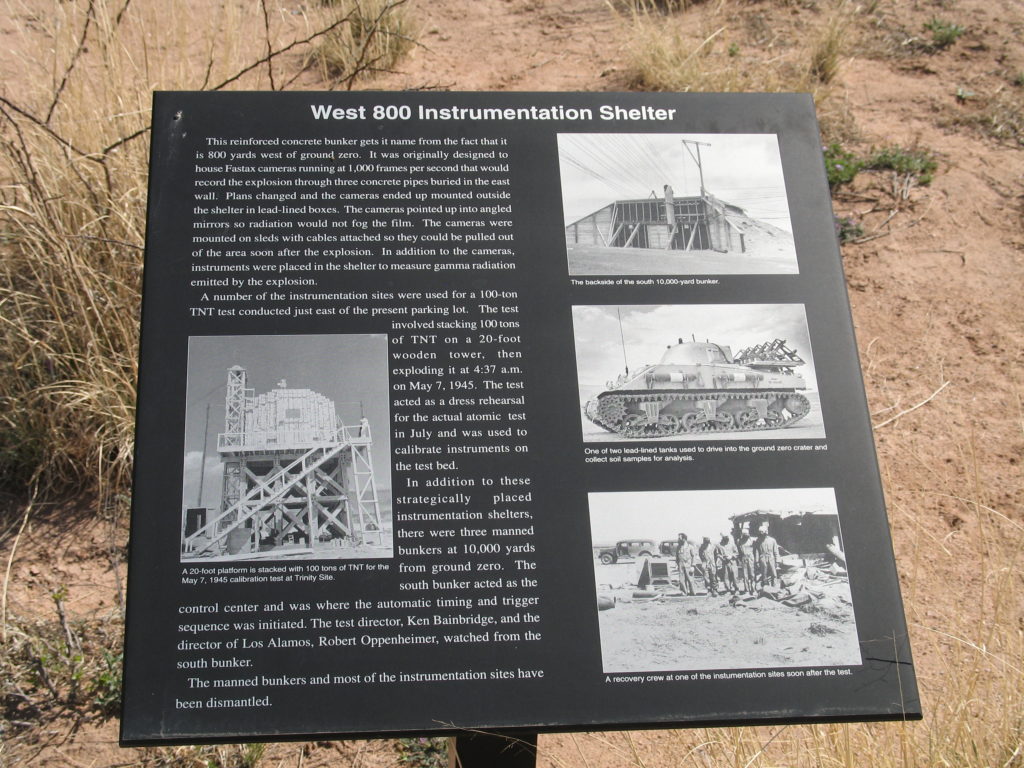
2. The Schmidt/McDonald Ranch
Location: 2 miles from ground zero (Google Map)
The McDonald House was where the plutonium core of the bomb was assembled on July 13, 1945, shortly before being tested. A private family previously occupied the house, which dates back to 1913. However, the US government appropriated it for military use in 1942. The family protested against the acquisition but lost. They believed the government would return the land to them after the end of the war, but it remained in military control. Today, there is a family history on the family that lived there as part of the exhibit.
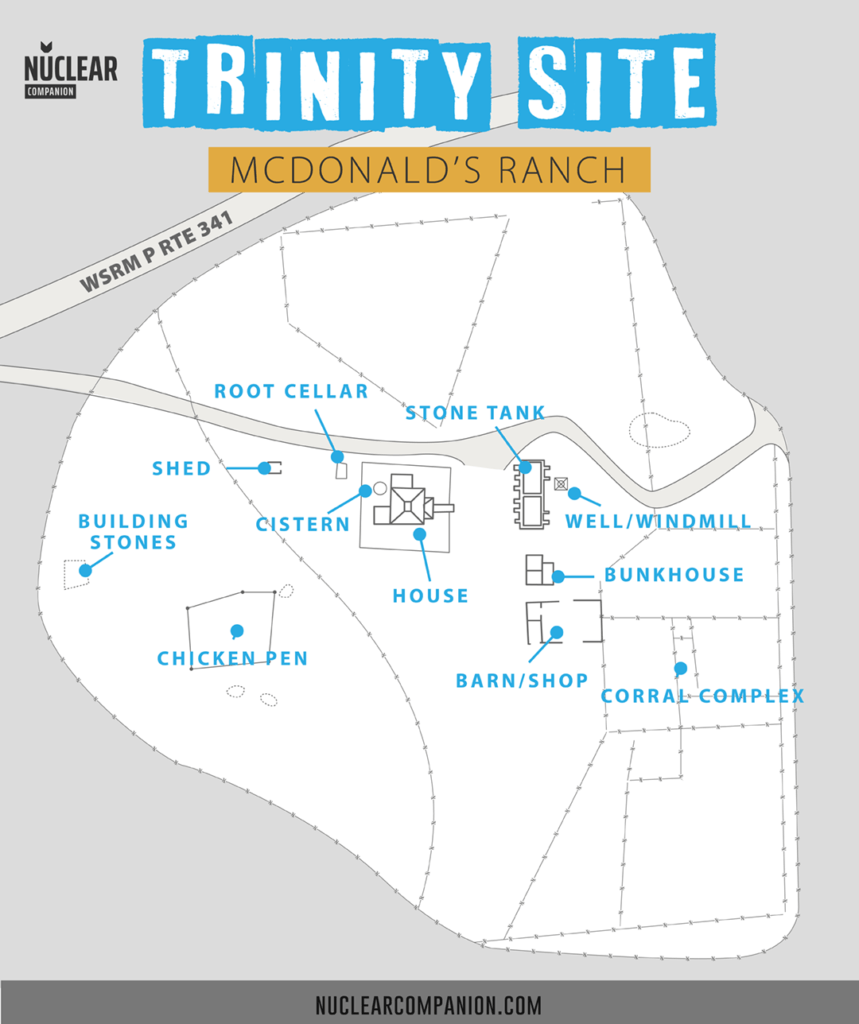
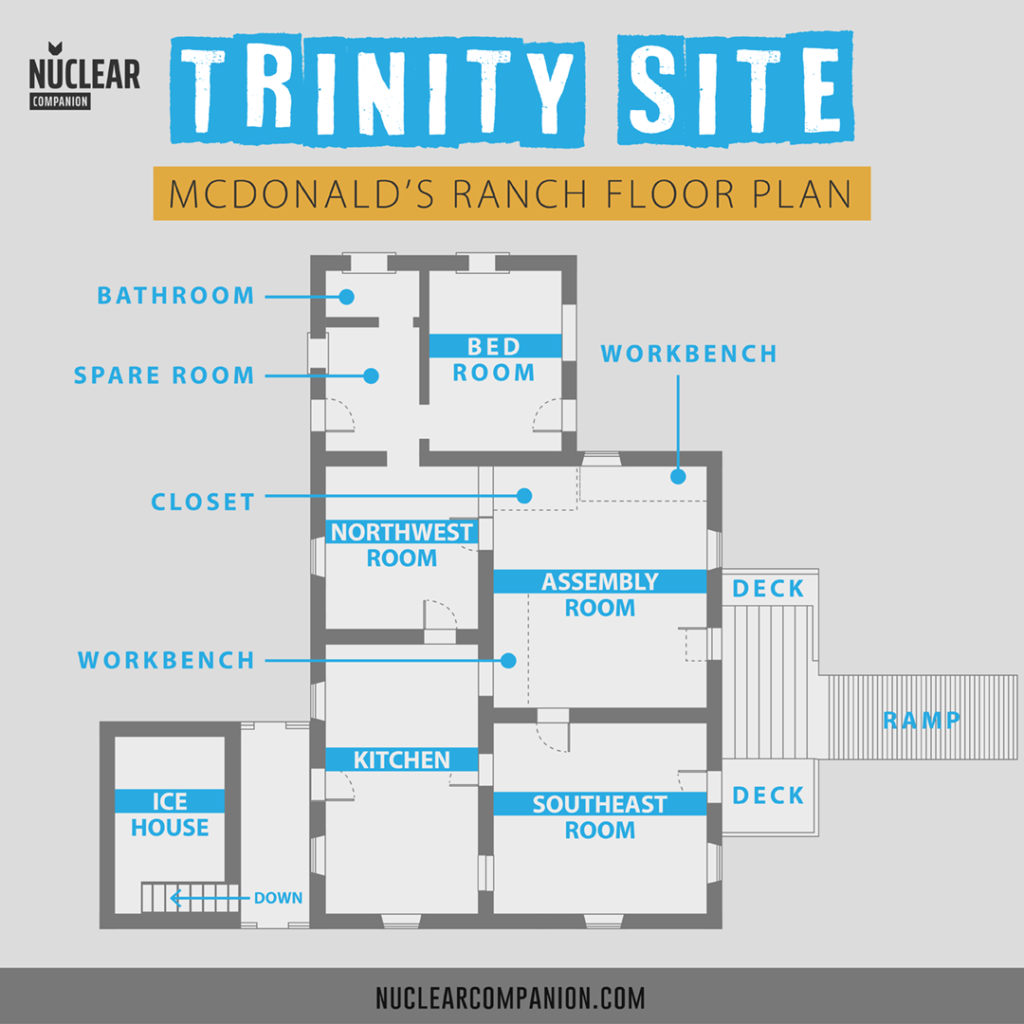
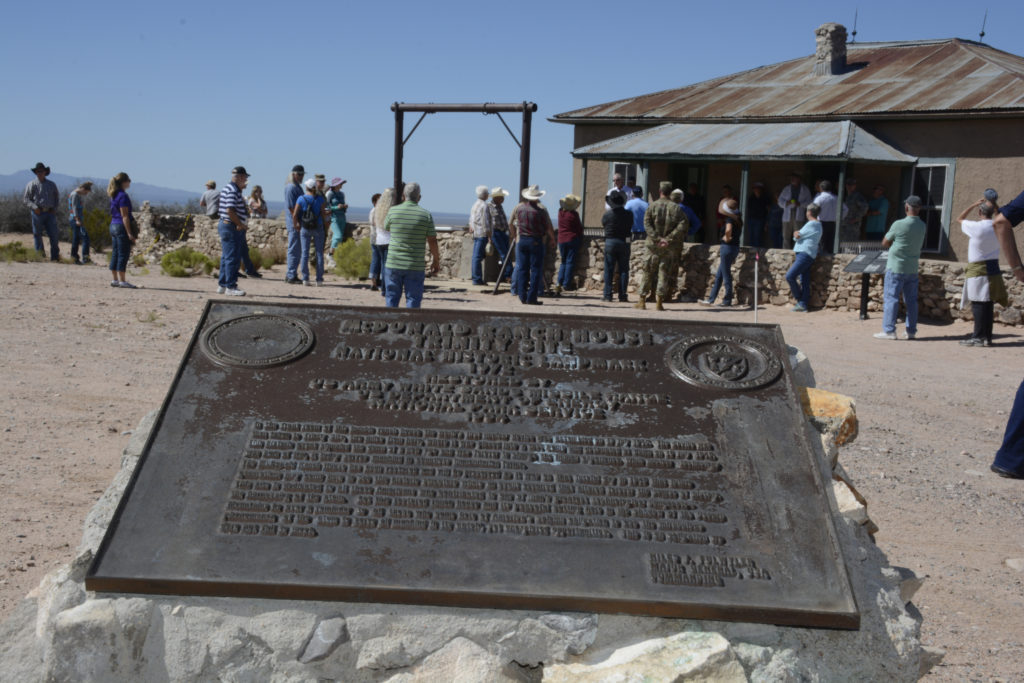
The McDonald House fell into disrepair after decades of neglect. In 1982, it was restored to look the way that it did on the day they constructed the bomb. Today, it is a must-see for anyone who is visiting the Trinity site. It is only open on the first Saturday of April and the first Saturday of October.
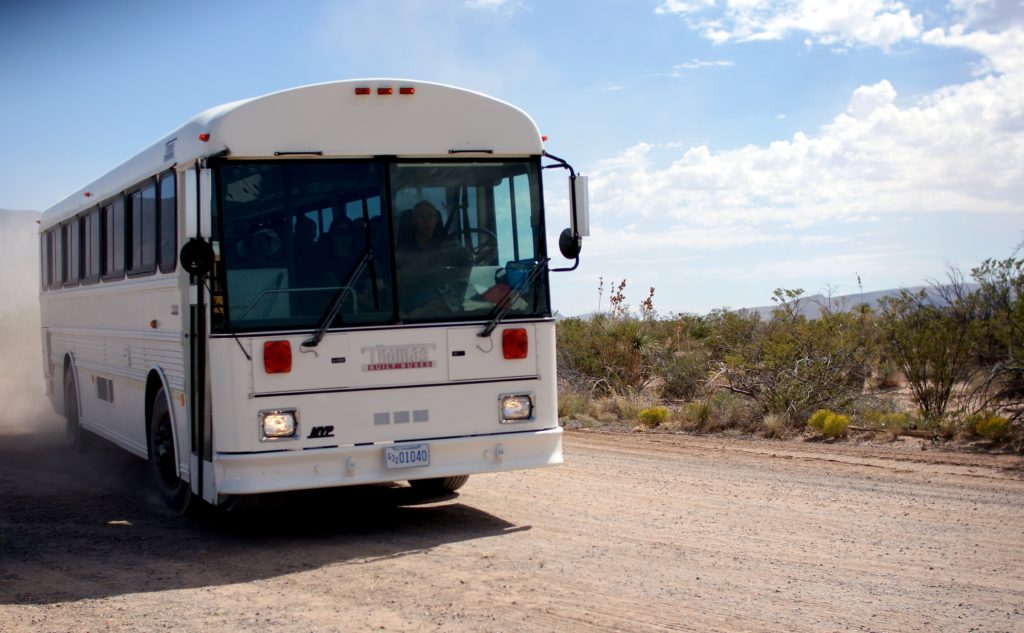
Touring the Ranch
There is a bus that takes visitors from Trinity Site to the ranch house. It departs every half hour from the Trinity Site’s parking lot south end.
The bus ride and visit to the McDonald Ranch take approximately 45 minutes round trip.
FAQs
You can see many of the structures either from the initial explosion or recreations. Some places include the assembly station known as the McDonald House. Another is the base of the 100-foot steel tower, where they dropped the bomb. A stone obelisk marking ground zero is also available for viewing.
The site is only open to the public two days per year, the first Saturday of April and October, from 8 am until 2 pm.
Admission is free. Keep in mind that there is no food or water available, so come prepared.
No. The site is an active missile range and military range, so it is strictly off-limits to the public on days that it is not open.
The only time that you can visit the site is on its open house days, the first Saturday of April and October.
You probably won’t find any accommodation around White Sands (with the possible exception of some Air BnB homes). Plan to stay in a nearby city, such as Alamogordo or even Albuquerque. However, keep in mind these locations are about two to three hours away, depending on traffic.
Trinity site is on the White Sands Missile Range, a highly secure military base. Make sure that you bring photo ID for everyone in your group, or you may not be allowed access.
Bring plenty of food and water. You will be walking around a lot, and in the desert heat, you may not realize that you have become dehydrated. Make sure that you bring enough water to sip on throughout your entire visit.
A Brief History of the Trinity Site
The Manhattan Project
During World War II, some countries from the Allied powers took part in what was known as the Manhattan Project. It was designed to develop nuclear weapons to help the Allies win the war. The Manhattan Project began in 1939. This assignment was so secretive that many of the 130,000 people who worked on it had no idea what they were actually working on.
The work began following a letter that Albert Einstein wrote to President Franklin D Roosevelt in 1939. Einstein was a German-born Jew who was visiting the US in 1933, the year that Adolf Hitler came to power; he chose to stay in the US rather than return to Europe. With the Nazi’s military expansion and the beginning of World War II, he received a tip that Nazi scientists were attempting to use the process of nuclear fission.
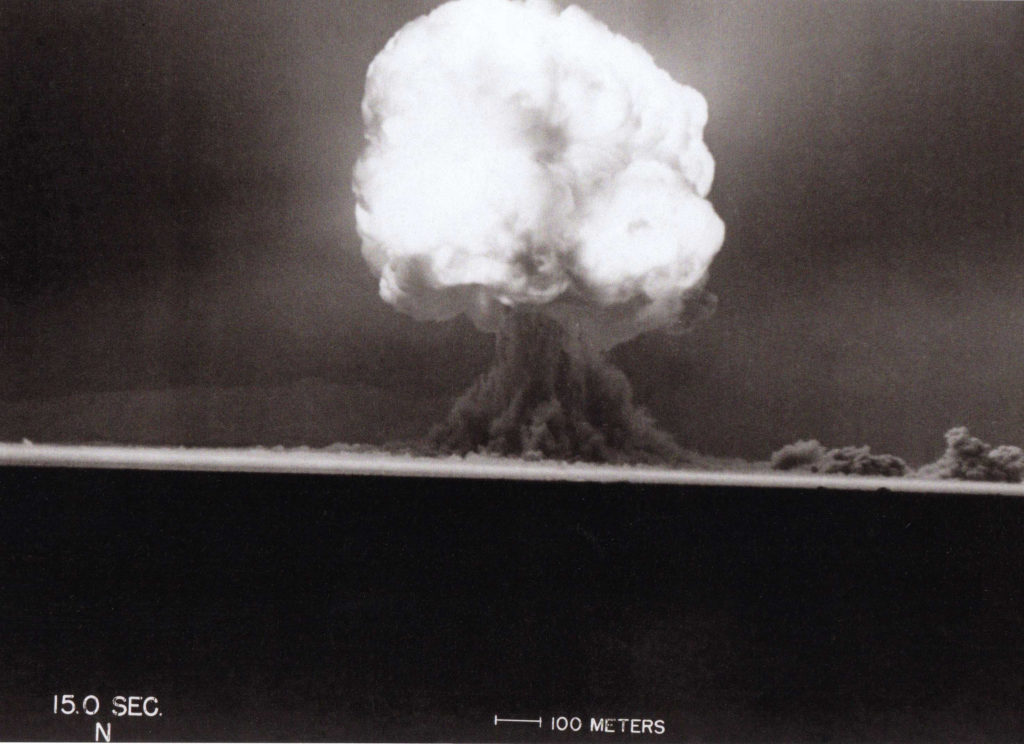
This notion meant they would release enormous amounts of energy, or basically a bomb. His letter to the president warned him of the impending danger should the Nazis succeed in developing such a weapon. Thus, Einstein urged him to beat the Nazis by building one first.
Ironically, because of Einstein’s political activism and German roots, he was denied the security clearance necessary to work on the Manhattan Project. In fact, scientists working on it were not allowed to consult with him in any way because Einstein was a threat to national security. Instead, the scientist who led the team was the nuclear physicist Robert Oppenheimer. He who famously declared at the bomb’s test site, “I have become death, the destroyer of worlds.”
Based on the letter that Einstein sent to Roosevelt, the United States began stockpiling uranium. It was with the understanding that uranium could potentially fuel a bomb many times more deadly than those previously known.
In 1941, the president created the Office of Scientific Research and Development, the OSRD, to oversee the creation of the bomb. He also formed an Advisory Committee on Uranium, which became the National Defense Research Committee on Uranium. The leaders of these organizations developed the S-1 Committee.
That first meeting of the S-1 Committee occurred on December 18, 1941, just 11 days after the attack on Pearl Harbor. The task could not be more urgent.
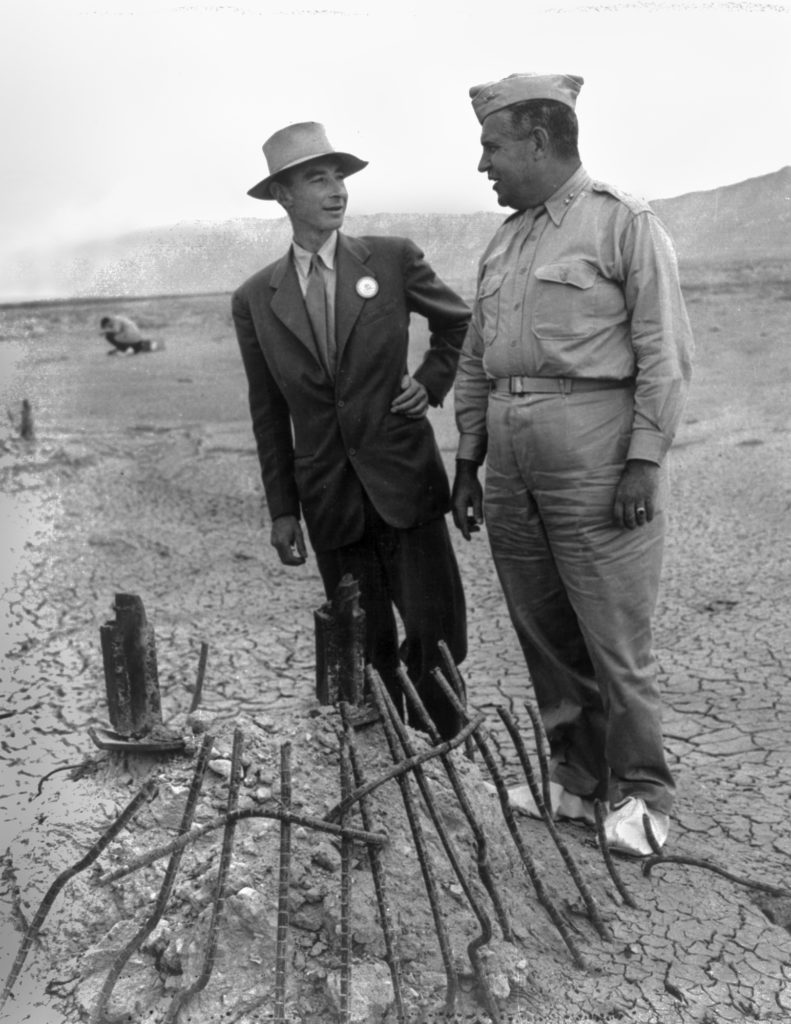
This team of scientists succeeded in creating a prototype bomb. However, it was from enriched plutonium rather than the uranium that the government had previously stockpiled, at the Los Alamos laboratory in New Mexico in 1945. The remote location of the laboratory enabled the team of scientists to work there in absolute secrecy. Likewise, the obscure, barren desert provided a perfect testing ground for the weapon.
Scientists would only get one chance to test out the bomb, so they had to do it right the first time. When it was carried out on July 16, the team knew that detonating the weapon had the potential to set the atmosphere on fire and obliterate all life on earth. The chain reaction triggered by the enriched plutonium led to the mushroom cloud appearing over the empty desert; it was then that the scientists knew that they had created the deadliest weapon in the history of the world.
When Albert Einstein learned that the bomb he had urged the president to build destroyed the Japanese cities of Hiroshima and Nagasaki, his response was, “Woe is me.” Though it helped end the war, hundreds of thousands of civilians died. Moreover, the world entered an era in which all life could end with the push of a button.
Today, the Trinity Test Site is a national historic landmark and is in the National Register of Historic Places.
Useful links
Trinity Site on the U.S. National Park Service site
Now it is your turn
Have you ever visited the Trinity Test Site? or, are you planning a visit?
Or maybe you have a question.
Let me know by leaving a quick comment below right now.
How far was the photo shelter from the blast on July 16, 1945?
I AM GOING TO BE 78 YEARS OLD NEXT MONTH. IF IT HADN’T BEEN FOR THE SUCCESS OF THE TRINITY TEST AND THE SUBSEQUENT USE OF THE LITTLE BOY AND THE FAT MAN AGAINST IMPERIAL JAPAN, I MIGHT NEVER HAVE KNOW MY FATHER OR ANY OF MY UNCLES!!!!! AND THE WAR IN THE PACIFIC COULD HAVE DRAGGED ON FOR DECADES, WITH MANY MORE MILITARY AND CIVILIAN CASUALTIES ON BOTH SIDES!!!!
I’ve never been there even though I’ve traveled Hwy 380 a few times. I would like to go this October 1, 2022. I travel with a well-behaved medium dog. Do you know if she can take the tour along with me? Is this tour a guided and timed tour, or is it a self-paced, self-guided tour?
Thank you for the very helpful information and advice in the article above!
Hi Scott,
Thanks for writing. Pets are allowed as long as they are leashed and their waste is picked up and put into a trash receptacle. Pets are not allowed on the shuttle that takes visitors to the ranch house.
Ground Zero in self-guided tour but theres is a 1/2 hour tour for the McDonald House.
Is a 4 year old child allowed with parent on the site?
Hi Gilbert, yes! All ages are welcome.
You wrote: “When it was carried out on May 7, …”
Obviously, the correct date is July 16, 1945.
Hi!. Thank you for pointing out this mistake. We indeed made an error with the date. The correct date for the Trinity nuclear test is July 16, 1945, not May 7. We appreciate your attention to detail and will make the necessary correction immediately. Thanks again!
I was stationed in Red Canyon for three years. (SEP 1955 – AUG 1958). I traveled all thru Red Canyon including the Trinity Site and McDonalds ranch, which I was under the impression was also an Overland Trail (stagecoach trail in the old west). There are areas in the site that also go back to a famous Indian, We searched a number of caves, The Diamond Sand (is what we as we called Trinite) was quite evident but was described to us as a result of firing off missiles, I have a bunch of stories that occurred during that period,